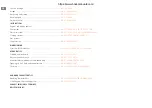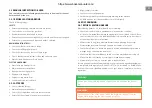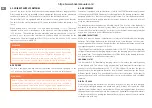
3.6 ANCHORING, DOCKING AND MOORING FASTENING POINTS
DOCKING
Always brief your crew how you are planning to dock.
Fenders and at least one mooring line fore and aft must be in place before approaching
the jetty.
It is always easiest to dock against the wind. Try to hold the bow exactly into the wind
and maintain sufficient speed for the boat to answer the rudder. If the bow is blown
off in one direction, back out and repeat the manoeuvre. Bring the bow up to the jetty,
and make sure you get a line ashore quickly.
Docking with a beam wind is a little more difficult. Do not steer parallel to the jetty
letting the boat blow in as there is always a risk of the bow being blown off towards
other boats or the jetty. Instead, try to manoeuvre the boat so that the wind comes
directly from astern. Then the boat can be manoeuvred straight ahead since the wind
helps hold the boat on a straight course. It is good to have someone on the foredeck
that can go ashore and quickly turn the bow in the desired direction after the boat has
stopped completely.
Try to always avoid sharp movements of the throttle, since idling speed in ahead
and astern is generally adequate. Sharp movements of the throttle can lead to panic
manoeuvres. Fastening points are indicated in the illustration in the picture below.
Points (or cleats) are located both at the stern, midship and bow. When anchoring or
towing, the forward force is 23,5 kN When mooring the forward force is 19,2 kN
When mooring the rearward force is 16,4 kN.
The tensile strength of the lines or chains should normally not exceed
the strength of the fastening point in question.
CAUTION!
22
https://www.boat-manuals.com/
Summary of Contents for 24 HT 2016
Page 1: ...AXOPAR 24 HT OWNER S MANUAL https www boat manuals com ...
Page 2: ...https www boat manuals com ...
Page 3: ...3 https www boat manuals com ...
Page 35: ...9 3 FUEL SYSTEM FOR NORTH AMERICAN REGION 35 https www boat manuals com ...
Page 36: ...https www boat manuals com ...
Page 37: ...37 https www boat manuals com ...
Page 38: ...38 https www boat manuals com ...
Page 39: ...39 https www boat manuals com ...















































